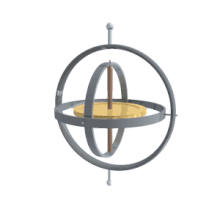The Hubble Space Telescope: A big success for the space industry
Introduction
The Hubble Space Telescope was a major success to the space industry when it needed it most. It could look at the stars more profoundly than any other telescope we had ever built. This was important as we had always been imagining what the universe might look like. The Hubble showed that to us. Though the James Webb Space Telescope is far better than this, the Hubble was also an achievement.
 |
| Image Source - Google | Image by - Wikipedia | The Hubble |
The beginning
On January 28, 1986, the Challenger disaster happened. People were mourning the deaths of the 7 people who were on board. They needed a big shot that could get them back into the game. And Hubble was a hopeful opportunity. People had been trying to measure the universe's age from the ground, so the level of uncertainty was also high. Charlie Pellerin, former Director of Astrophysics at NASA was held in charge of the Hubble. Pellerin was inspired by Kennedy’s quote, ‘We chose to go to the moon not because it is easy but because it is hard. So he chose Hubble as he thought it to be hard. And the proof was the many problems that occurred in his way while creating the Hubble.
 |
| Image Source - Google | Image by - Imdb | Dr Charles Pellerin |
The direction in which Hubble points
The Hubble would be orbiting the earth at an astonishing speed of 5 miles/s. That would be a problem because this speed would result in a tendency to keep rotating and tumbling. But to take clear images the Hubble would have to be still. The solution to this problem was gyroscopes. Fascinating instruments that could balance themselves even on strings if they are rotating. So they were good solutions to keep Hubble stable. Hubble was equipped with 6 of the best and most precise gyroscopes ever built. They are spinning 320 times per second!
 |
| Image Source - Google | Image by - Wikipedia | A gyroscope |
Hubble’s flawed mirror
Before the Hubble was launched the gyroscope problem was inspected clearly. When it was deployed by the space shuttle, everything went according to plan. 2 months later, when Hubble sent its first image, it was blurred. This was a problem. Hubble had a mirror of 2.4 m which was not able to focus light. It was such a precise mirror that if it would have worked properly it would have focused all of its light on a single spot. Even a little bit of irregularity would not focus light. And that was the case. People were criticizing NASA for this. Pellerin was also in great tension. He was in charge of this $2 billion mission on which they had spent 15 years. Hubble became a target of jokes in newspapers. NASA was embarrassed. Pellerin was determined to fix this issue so he asked his team to look for a solution. After some time the team said that they might have a solution. Suppose there is a vision problem with your eyes. You go to the doctor and the doctor most probably gives you specs to wear. But what do those specs do? The light which your eyes were not able to focus properly, the glasses focus them. The same was the case with Hubble. It needed some lenses that could focus the light. So they created a machine called COSTAR or Corrective Optics Space Telescope Axial Replacement. This had 5 pairs of mirrors on motorised arms. This had to be applied to the Hubble. But this was not easy as the repair was to be done in space. The repair which was to be done was replacing one of the scientific instruments on Hubble called a photometer with COSTAR. When the COSTAR is installed, it will deploy its mirrors and the Hubble will start working properly. After the repair had gone fine, the crew came back. After 11 days everything was settled and Hubble was about to send its first clear image on 18 December 1993. This was the great victory of humans over a great failure.
 |
| Image Source - Google | Image by - WIRED | Hubble's first image after repair |
The Hubble Space telescope can take more clear pictures as telescopes on earth are often bound by the atmosphere and Hubble had no such limitation. After working for many years, we are now seeing its successor, The James Webb Space Telescope doing great things
Comments
Post a Comment